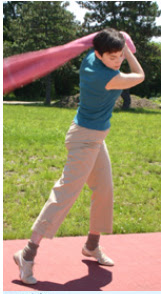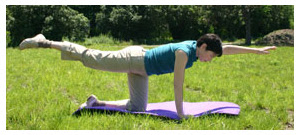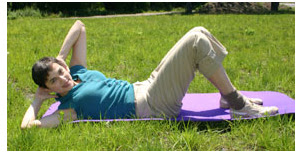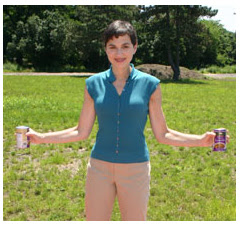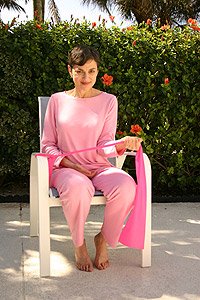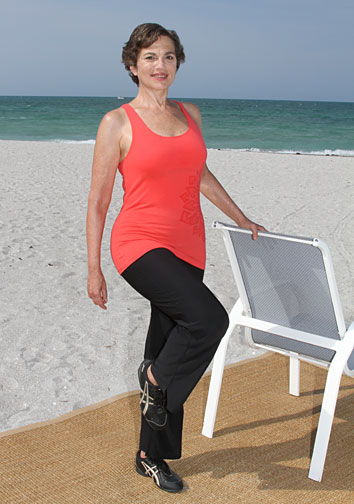Golf Exercises
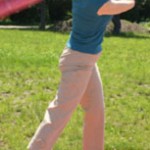 There are over 20 million golfers in the United States alone. And those who play frequently, including the pros, are often plagued by over-use injuries.
There are over 20 million golfers in the United States alone. And those who play frequently, including the pros, are often plagued by over-use injuries.
It’s the repetitive motion of the golf swing that’s the culprit. And if your form is less than perfect you can hurt yourself on a single swing.
It uses the same muscles every time: mainly shoulder (rotator cuff) core (side of the waist, abdominals), and arms (elbow, forearm and wrist)
Also, like any other physical activity, it’s good to warm-up your body at least 5-10 minutes before starting to play. A brisk walk, a few arm circles and practice swings with a towel will help to elevate your body temperature, lubricate joints and increase blood flow to your working muscles.
As for the current aches and pains, you probably have to rest those muscles until they heal.
The good news is, there are Prehab golf exercises to help you play injury-free in the future and they will also help improve your game.
Here are some essential exercises.
Essential Golf Exercises:
Towel warm-up
Roll up a towel lengthwise and take a few practice swings to warm-up the muscles you’ll use when you add the weight of the club.
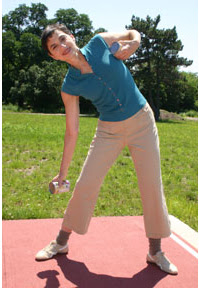 Golf Exercises: Side Bend
Golf Exercises: Side Bend
If you have hand weights, great. Otherwise, grab some cans from your pantry.
Stand feet shoulder width apart, knees slightly bent, arms at your sides. Without bending forward or back, bend directly to one side, while sliding the weight in your opposite hand up the side of your body to your armpit. Do the same on the other side. 8-12 reps on each side, alternating side to side. Areas Worked: Side of the Waist
Golf Exercises: Core Strength & Stretch
Start on your hands and knees in a tabletop position.
Gently stretch your right arm out in front of you till it’s level with your torso. At the same time raise your left leg and straighten it behind you. Hold for 10-20 counts and slowly return to starting position. Switch sides and repeat. Areas Worked: Abdominals, shoulder, hip and back of leg
Golf Exercises: Oblique Twist
Lie down, knees bent, feet hip width apart. Place your hands behind your head.
Lift and turn your torso to point your right elbow towards your left knee (keep your elbow back in line with your shoulder) and return to start. Do 8 reps. Switch sides and repeat. Areas Worked: Abdominals, particularly the side abs.
Holding cans or hand weights bend arms at the elbows to 90 degrees in front of you. Keep your elbows bent and bring your arms out to your sides.
Repeat 8-12 reps.
Areas Worked: Shoulders
Golf Exercises: Wrist Curls
 Hold hand weights at your sides, elbows at 90-degree angles, palms down. Keep arms stationary, and using only your wrists, slowly curl the weights towards you until your knuckles are facing the ceiling. Repeat 8-15 reps
Hold hand weights at your sides, elbows at 90-degree angles, palms down. Keep arms stationary, and using only your wrists, slowly curl the weights towards you until your knuckles are facing the ceiling. Repeat 8-15 reps
Flip weights palms up. Do 8-15 reps in this position.
Areas Worked: Forearms and wrists.
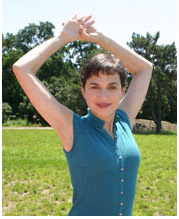 Golf Exercises: Diamond Stretch
Golf Exercises: Diamond Stretch
Raise arms over-head, linking hands together. Slightly bend elbows and gently move them back.
Hold for 10-20 counts.
Areas worked: Shoulders, chest and upper back.
 PUT FabFall at checkout and get 20% off. Good until 10/31/16
PUT FabFall at checkout and get 20% off. Good until 10/31/16
For more info on health and wellness programs please visit www.mirabaiholland.com
Follow Mirabai Holland, Certified Health Coach & Certified Exercise Physiologist:
Send your Moving Free® with Mirabai questions to askmirabai@movingfree.com

